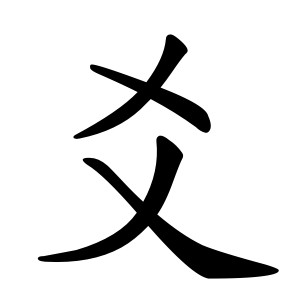爻
- to interweave, to cross;
It specifically refers to the symbols that make up the eight trigrams (八卦 bāguà) in the I Ching (Book of Changes).
Etymology
The character 爻 is considered the original form of the character 學 (study/learning). There are two main interpretations of its origin.
Pictograph interpretation: It depicts long wooden beams crossed in an X-shape at both ends of a roof in ancient architecture.
Ideograph interpretation: It represents the overlapping of two X-shaped crossing marks, forming a cross, symbolizing “to cross” or “to interweave.”
Usage in Korean
Information related to 爻 in the context of I Ching (易經) divination
In the concept of "수효(數爻)" (counting yao/lines), 爻 refers to the horizontal lines that form the trigrams and hexagrams in the I Ching.
A single horizontal line “—” represents yang (陽), and a broken line “--” represents yin (陰).
The lines are counted from the bottom upward, named 초효 (first yao), 이효 (second yao),..., up to 상효 (top yao).
Each yao symbolizes the nature and changes of things, and combinations of yao create trigrams and hexagrams which express the laws of change and principles of the universe.
Therefore, 爻 represents both the symbolic lines and the concept of numbers corresponding to the nature and transformation of things.
Additional notes
It refers specifically to the intersecting or alternating lines (broken and unbroken) used in divination diagrams such as the I Ching (Book of Changes), representing yin and yang interactions.
- 大大 (KK)
- ⿱ 㐅 乂
